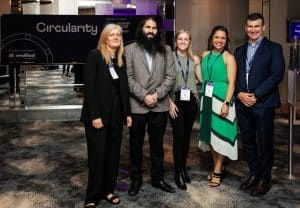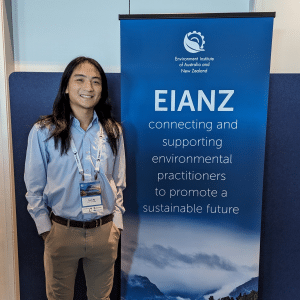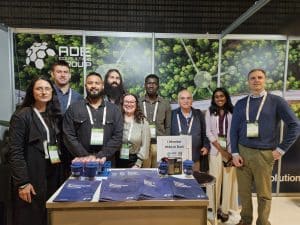The International Day of Women and Girls in Science on the 11th of February commemorates the achievements of females in science and promotes their full and equal participation in science-related disciplines. It also aims to recognise the critical role that women and girls play in Science, Technology, Engineering, and Mathematics (STEM), as well as addressing the gender disparities that still exist in these fields.
In honour of this important day, we had the privilege of speaking with four remarkable women from our Sydney team (left to right): Megan Lynch, Miranda Chau, Marjetica McAuley and Ankita Saxena. They shared their unique journeys and insights on navigating the diverse landscape of STEM, and the advice they would give to the women and girls wanting to pursue a career in these areas.

1. Tell us a bit about yourself, your background, and your current role.
Megan: I took the long way around into Environmental Science. I’ve had a career in Communications, as well as owning and running farms, and have even started a company developing urban farming before coming into STEM. I now work at ADE as an Environmental Consultant in the Health and Safety Services team.
Miranda: I am a creative person and have a strong passion for arts, design, and crafts. I have worked as a draftsperson for over 17 years; starting in a pharmaceutical company doing electrical drafting, then transitioning into the Environmental and Geotechnical field.
Over several years working in this field, I grew to appreciate and show more interest in my work as a draftsperson. In 2010, I decided to pursue further studies and expand my career opportunities by completing a postgraduate degree in Hydrogeology and Groundwater Management.
Since then, I began working as an Environmental Scientist with the combined role of a draftsperson. Drafting is still my number one passion as a career. This year is my fifth year working at ADE Consulting Group as a CAD Draftsperson, supporting the Environmental, Geotechnical and Health and Safety teams and across the divisions nationally when required.
I am also regularly involved in volunteering and giving back to the community. Throughout the week and on weekends, I work actively as a volunteer at the Chinese Parents Association – Children With Disabilities (CPA) – a non-profit charity organisation established in 1988. Through my role as president of the association for the past 11 years, I have been organising weekly classes and social gatherings for people with disabilities and their families, and run support groups for parents. I am also a volunteer at Canterbury Hospital as an active member of the Community Consumer Network team, having recently donated one of my paintings titled “My Journey” as part of the hospital’s ‘March Arts 2023’ project.
Marjetica: I’ve amassed experience over more than three decades coordinating trades, in tendering, contracts and training, delivering multidisciplinary engineering solutions, developing and managing successful teams and project management consulting.
Five years ago, after nearly a decade in Southeast Asia, a former colleague introduced me to ADE, which presented an unexpected opportunity. I pivoted to support and develop a new Health & Safety Services (HSS) department expanding into occupational hygiene, noise and vibration disciplines, mould assessments, digitising hazardous materials building audits and latterly taking my personal interest in the subconscious to psychosocial and wellness.
I’m ADE’s Health and Safety Services Manager who has a dry sense of humour and a broad but exquisite taste in food, wines, scotch and, significantly, people. Family-centred, I’m also keen on holistic health, clean foods, making the most of skills and talents and, functionally, integrating yet simplifying to make work and life easier… because life is too short!
Ankita: Originally from India, I moved to Australia four years ago to pursue my passion for the environment by undertaking a Master’s degree at the University of Wollongong. For the past 18 months, I have been working as an Environmental Consultant within the ADE Sydney Environment team, and I am eagerly looking forward to the opportunities that lie ahead.


2. When did you first become interested in a career in STEM (Science, Technology, Engineering and/or Maths) and what attracted you to it?
Megan: I had a terrible maths teacher in years 9 and 10, which are critical years for establishing a core understanding and appreciation for science topics. But I have always loved geology and chemistry – it linked science into the daily life of growing up on the farm. I worked on sustainability projects for Ericsson and Volvo, and even did a stint at the United Nations Framework Convention on Climate Change, but it all felt like ‘window dressing’.
Miranda: Science is important in our daily life. There are so many aspects of life that are impacted and defined by scientific knowledge. This was one of the reasons that drove me to pursue a career in STEM. I’ve never looked at a career in STEM as a gendered job.
Marjetica: Sounding more destructive than it actually was, I was a ‘hands-on’ toddler: assembling and deconstructing my tricycle. I progressed to tinker under the bonnet with the hydraulics of the family Citroen DS 21, changing out the brake pads, etc. By secondary school, I fancied becoming a mechanic or a doctor, while my dad hinted that business school (TAFE) or architecture might be a more appropriate choice for his three daughters. With migrant parents who didn’t have an opportunity to complete their own schooling, study wasn’t paramount: helping out, practicality, and sensible future-proofing were.
Considering STEM, the cliché ‘enjoyed all sciences’ and critical thinking rings true. I thrived on experiments, analysis, physics, as well as commerce and English. Wide interests and hobbies across disciplines and industries, and a passion for teaching and learning led me to a Bachelors and Research Masters in Chemical Engineering. This enabled me to consult across the breadth of process and environmental engineering projects. Lifelong work would be assured considering that exposure guidelines would become increasingly stringent over time.
Ankita: I have always been a curious child who was fascinated by science and numbers (and finding the value of x). My childhood memories are filled with train journeys across India, during which I became acutely aware of the pressing issue of waste management and its negative impact on our health.
I was compelled to investigate how the country was addressing this challenge, only to find, much to my dismay, that not enough was being done to mitigate this escalating problem. More alarmingly, there was a general lack of widespread awareness and education about the issue. It was at this moment that I realised my calling to contribute positively in this field.
Guided by my father, who himself is an engineer, I found a way to merge my fervour for STEM disciplines with my burgeoning interest in environmental matters. Consequently, I decided to pursue a Bachelor of Environmental Engineering,


3. Tell us about your education experience when studying to pursue a career in STEM.
Megan: In year 11 in 1987, when choosing subjects, I wanted to study geology, but only three other girls and one boy expressed interest. As a way of discouraging us and trying to get us to choose something else, it was also made clear that ‘us girls’ would never get jobs in geology. So instead, I pursued the humanities route. Eventually, I had to go back to school to do the science subjects required to pursue an Environmental Science degree. Thankfully, that was a while ago and things are changing.
Miranda: 20 years ago, after ten years of being a full-time mum since completing university, I was introduced to the drafting trade through my TAFE studies. I remember when I first walked into the class, I found myself to be the only female student amongst 15-20 male students. As a young woman coming from an Asian family and being raised in a cultural and traditional household, I felt a bit odd and uncomfortable initially. In fact, I almost decided against completing the course, but I quickly learned not to let stereotypes like these discourage me from my goal of pursuing a career in STEM.
Marjetica: The local high school had me choose between industrial technology and physics, and either four-unit maths or three-unit commerce. I chose variety and the latter subjects to suit my chosen degree. My Chemical Engineering cohort had about 65 students, nearly 25% of whom were female. The high contact hours meant that Chemical Engineering was not offered as a double degree with Commerce. Still, Chemical Engineering ticked all the boxes for flexibility: physics, chemistry, mathematics, materials, computing, mechanical and electrical, thermodynamics, as well as EIS, project design, and management subjects in the thesis-honors year.
Enabling memberships with IChemE(UK), Engineers Australia, and water associations, the honours year degree offered ready opportunity to work abroad. Skills in statistics, HAZID, HAZOP, pollution exposure controls, environmental and human health risk assessment in both design and operation, proved foundational for my repatriation and current workplace processes, exposures and occupational hygiene role.
Working within renowned multidisciplinary consultancies, international experience in tendering, design engineering and management of engineers and processes, offered a myriad of projects with recognised professionals that continues to provide for life-long learning.
Ankita: My initial year in engineering studies was both intriguing and enjoyable, providing me with a broad overview of various disciplines before delving deeper into environmental engineering during my second year, where I explored both theoretical and practical aspects. The curriculum included numerous field trips, allowing me to observe firsthand the operations of water and wastewater treatment facilities, as well as the application and regulations of noise monitoring equipment.
Upon completing my Bachelor’s degree, I felt the need for further education and experience, which led me to pursue a Master’s degree in Australia. Regrettably, due to the COVID-19 pandemic, my course transitioned to an online format. Despite this, I was still able to immerse myself in Australian culture and study a diverse range of subjects that the country had to offer.


4. What are the biggest challenges you have faced as a woman in STEM throughout your education and/or career?
Megan: For me, it was starting over and going back to university at the age of 41. In doing so, there was a general assumption that I wouldn’t want to get my hands dirty. I’m not sure if that was to do with the fact that I was 41 or that I was a female, but it was an assumption I encountered.
On site, I have always been impressed with the general acceptance. Occasionally, interactions can come across as being slightly patronising – imagine the John Wayne voice: “You okay there little lady? Let me show you how to turn that car on.” However, in line with the positive social changes occurring for women in STEM, there is an increasing respect for female workers in the field.
Miranda: The challenge of balancing work and taking care of my children has been taxing on my mental health. This is particularly challenging, as my son has autism and requires additional care. On top of these duties, I was also undertaking part-time study at the same time. However, my determination has always kept me motivated and in control as I pursued the path to achieving my goals, I managed to balance it all!
Marjetica: Suitable apparel. I’ve had the same site-ready office-wear formula my whole career (some would say: “‘you can tell”’): a tailored jacket over a t-shirt, relaxed trousers with deep pockets, and boots.
Being second-guessed or hearing your suggestions as an ‘innovative idea’ attributed to some other fellow, smarts a bit. Every time. Fortunately, gender equity has made great leaps.
Male professionals tended to discuss projects in passing (pardon the pun), in the bathroom, offsite at lunch, or over a drink. Less frequent today, the practice excluded juniors, particularly women who would, necessarily, ‘catch up’ at the next project meeting.
A surprising challenge was presented at my first team meeting upon starting work ‘on the Wirral’ near Cheshire. Ten other discipline leads, each of whom hailed from a different part of UK or Ireland, heard that a young, female Aussie process engineering principal was recently hired, so took to speaking in their own very thick accents, loading their conversation with as many local idioms and company acronyms as they could conjure to see my reaction. They turned out to be the most welcoming and respectful colleagues. However, the experience cemented by my non-English speaking heritage, informed my habit to either speak like a local, or else select non-ambiguous words and language with pronunciation clarity and cadence suited to the audience when traveling or teaching abroad, or speaking with multicultural teams.
Ankita: I have had the privilege of studying at prestigious universities in both India and Australia. Nonetheless, being in a male-dominated field, I have generally witnessed how ideas raised by women can be perceived differently from those spearheaded by men. However, I am happy to see these attitudes changing as more women enter the STEM industry. These challenges underscore the ongoing journey of women in STEM as we continue to establish our presence and impact.


5. What are your favourite things about working in STEM?
Megan: The variety of the job is awesome. Some days I’m analysing data, and then the next I’m out in the field collecting samples. Fieldwork is also so varied and a real privilege. I get to go to some amazing sites: signaling tunnels under the rail network, ghost platforms, tops of buildings and wild natural areas. I love the mix of site work, analysis and reporting.
Miranda: My favourite thing is that I get to do what I love. My work as a CAD draftsperson means I get to create detailed plans every day for ADE. It feels great to know that I play an important role where I work, that my drawings support multiple departments, and that I get to learn something daily.
Marjetica: Continual improvements through new developments or technology, geared toward better solutions or outcomes.
Spurred by developments in IT, the ability to be in touch with peers and experts worldwide.
In a project-rich environment such as consulting, the flexibility of working on almost any type of project, including R&D, process, people, training, as well as the preservation of health, safety and environment.
Ankita: Delving into the latest research and development in the environmental field has been incredibly enriching, keeping me at the forefront of pivotal advancements. Collaborating with a diverse group of brilliant minds at ADE and in the industry has been enlightening, offering insights into their unique journeys and perspectives. Being part of a dynamic, passionate team has amplified my motivation and commitment to environmental preservation. Being able to contribute towards a sustainable future highlights the importance of our work in driving positive environmental change.
6. What advice would you give to a young woman who is interested in pursuing a career in STEM?
Megan: Whatever are you passionate about go for it – science and technology subjects can provide the core building blocks for your career. Regardless of what you eventually end up doing, STEM subjects really provide a lot of choices and in the end, that’s what it is all about.
Miranda: Everyone has the opportunity to reach their full potential. If you are passionate about learning and working in the STEM field, do not let gender stereotypes prevent you from doing anything you are passionate about. You should first decide what you want, understand how you want to progress in your career, and then find a company that helps you do it.
Marjetica: Consider what you would like to do and whether it may evolve to continue to suit you into the future, then choose your studies. Understand what the different routes to your ideal job could be and build in flexibility. Consider your strengths and weaknesses for the likely roles that the career path may present.
Embrace working abroad (and the opportunity for travel, languages, foods); it’s enriching for management and perspective.
Take the opportunity to work flexibly when it’s on offer and demonstrate its benefits. This is a great thing for women in STEM. Pay it forward.
If taking time off work, consider ways to stay engaged, top up your superannuation, and don’t feel guilty for enjoying family time or tending to carer responsibilities. This is a vital role in society.
Ankita: Go for it! It is a rewarding journey, full of opportunities to learn and contribute to our society, and you’ll have fun doing it!
7. Do you have any other comments or words to share about your experience in STEM that have not been covered by the questions above?
Megan: STEM careers are so rewarding and women in STEM roles have amazing opportunities as more businesses improve the gender balance. Gender inequalities of the past are changing quickly, so it really is the time to pursue your passion.
Miranda: It feels great being a role model in STEM to my daughter, and to inspire other women to join in STEM!
Marjetica: Choose the types of roles for your capability, personality, stature and time in life. Consider how prepared you are to engage at work, being honest to secure the best fit. However, working a little beyond your comfort zone can also be rewarding and ensures you do not stagnate. Allow some flexibility to evolve and do not compare your lot with others… staying clear of social media might help with that. Someone else’s career model may not be your ideal!
Ankita: I would love to take this opportunity to thank the ADE team, who have been extremely supportive and empowering in dealing with the issues women face in STEM careers. I am grateful to learn and to be part of the team!





